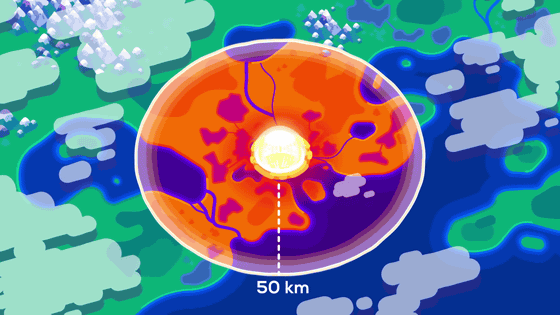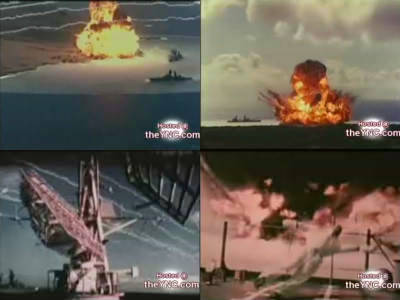What happens if you shoot a nuclear weapon on the moon?

The plan to 'build a military base in space' exists not only in the science fiction world but also in reality. Kurzgesagt, a scientific YouTube channel, explains in a characteristic animation movie the scenario of 'shooting a nuclear weapon in the moon' that can occur when a military base is built on the moon floating in the night sky.
During the Cold War , the Moon was a major goal of space exploration, and there were plans to build a military base on the Moon. To counter the military bases built on the moon, the U.S. Air Force seriously conducted a study on 'what could be the consequences of shooting a nuclear weapon on the moon?'

In this movie, let's consider a case where a super-powerful nuclear weapon of 100 megatons in TNT equivalent, which is twice as powerful as

At the moment of activating the nuclear weapon that was shot into the moon, a fission reaction occurred inside the nucleus of the radioactive metal evoked by the shock wave, and a high temperature plasma of 100 million degrees was generated. One second later, the fusion reaction begins.

Simply put, the inside of a nuclear weapon is the hottest in the universe. Then, just 10 milliseconds after the fusion reaction occurs, the outer surface of the nuclear weapon begins to melt, causing a nuclear explosion.

The reaction so far is no different from the nuclear weapons used on Earth. However, when shooting nuclear weapons on the moon, there is a difference that 'the atmosphere does not exist'. If it were to explode on Earth, the 100-megaton-class nuclear weapons envisioned this time would burn objects within a radius of 50 kilometers.

The absence of the atmosphere on the moon also means that there is no oxygen consumed for combustion. In addition, the lunar surface has silicate rocks and metallic dust created by repeated meteorite impacts, and very little water, so there are no burning objects.

Therefore, if a 100-megaton-class nuclear weapon explodes on the moon, the combustion will not spread. However, the heat generated will kill all living things within 50 kilometers.

Also, on the earth, there is a phenomenon that the plasma generated by a nuclear explosion is stopped by atmospheric pressure.

When the held plasma reaches the atmosphere, the compressed air around the plasma is released and a shock wave is generated. This shock wave is the most destructive phenomenon of a nuclear explosion, causing the surrounding buildings to collapse and producing a loud volume that bursts the organs of living organisms.

However, since there is no atmosphere on the surface of the moon, no shock wave is generated by a nuclear explosion. A nuclear explosion on the surface of the moon is an eerie phenomenon in which a fireball just swells in the tranquility.

The swelling of this fireball may be spectacular from a safe distance. However, there is no 'safe distance' because there is no atmosphere that attenuates

In addition, 100-megaton-class nuclear weapons affect the moon itself. About one-tenth of the energy generated by the explosion is converted into

In addition, a 1-kilometer-diameter crater is formed at the hypocenter, and the impact causes 100 million cubic meters of dust and rock to spread around.

Since the moon has no atmosphere and weak gravity, the majority of scattered dust and rocks fly out into outer space. Most of the

Also, in a nuclear explosion on the ground, a

On the other hand, even if a 100-megaton-class nuclear weapon explodes, the orbit of the moon will not change. Moving the moon with a nuclear weapon is like trying to blow a truck to move it, and the scars that a nuclear weapon leaves on the moon are about the same size as other craters.

However, the effects of nuclear weapons on the creatures on the moon are enormous. Radioactively contaminated substances from the explosion fall on the surface of the moon. However, these radioactivity levels will also decay to the same level as

Kurzgesagt concludes the movie with 'shooting a nuclear weapon into the moon has little effect on the moon itself, but it's likely to ruin the structures that exist on the moon, so you shouldn't do it.' rice field.

Related Posts:







